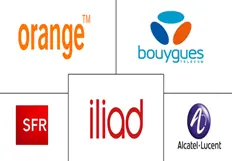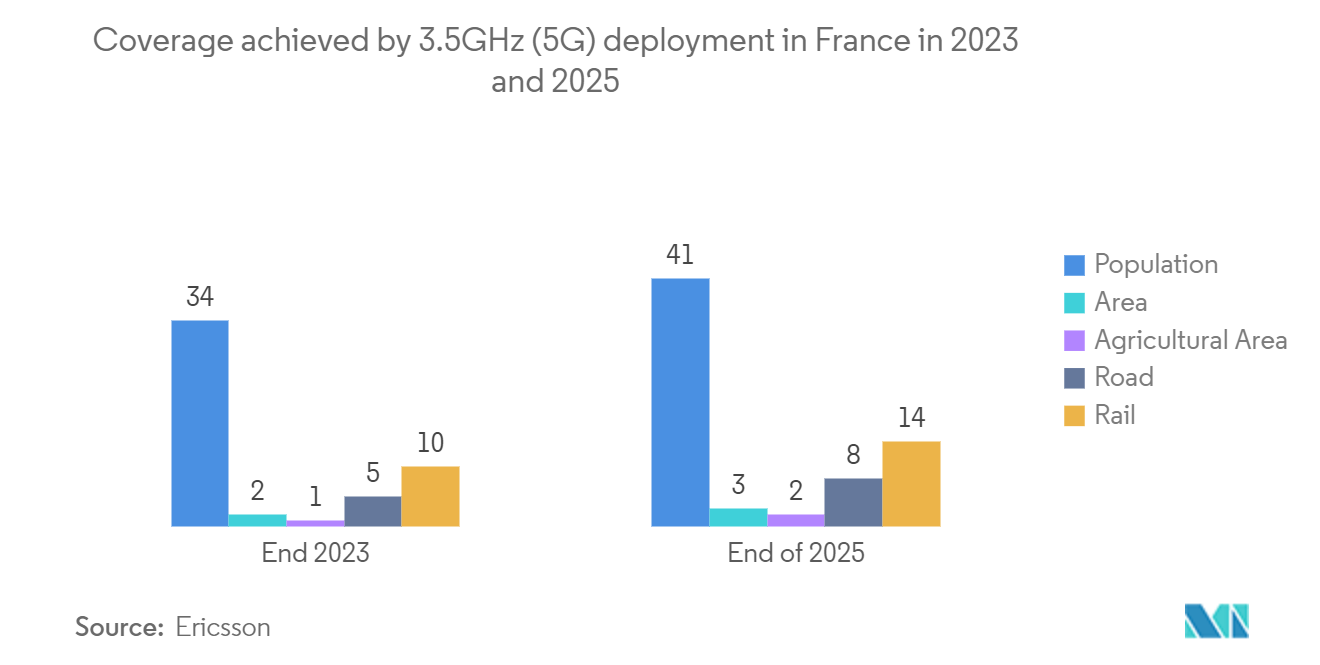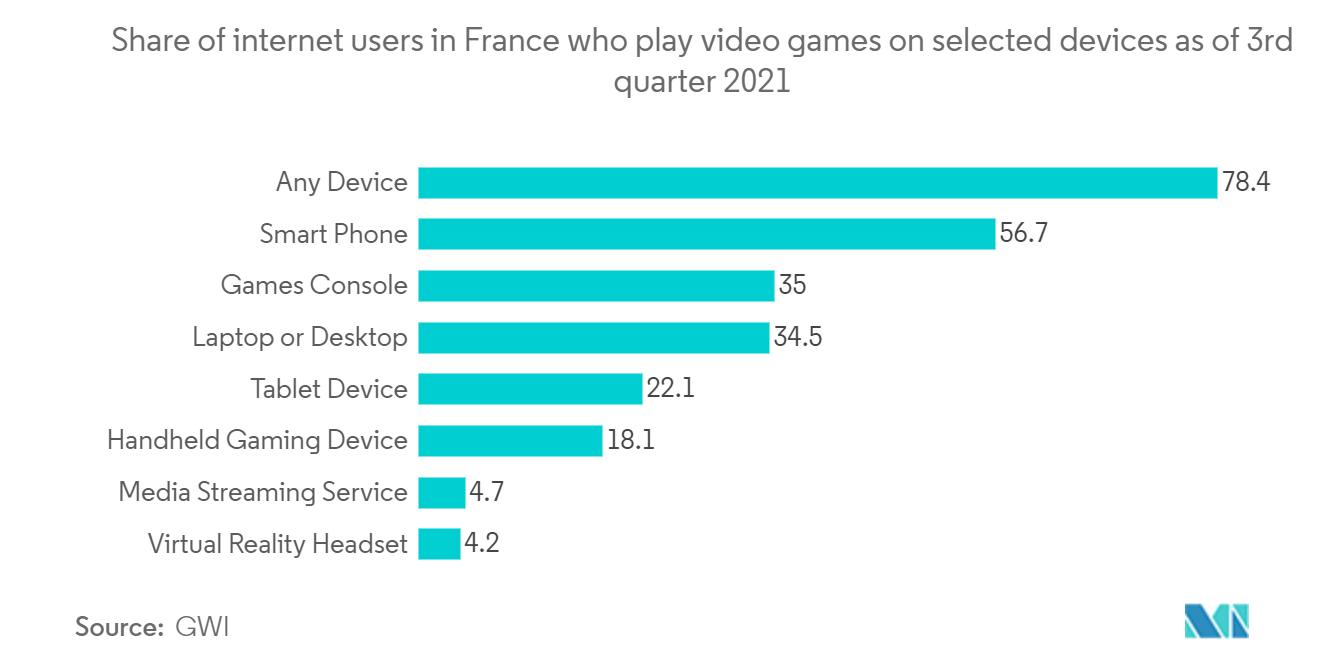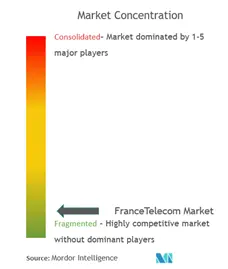
| Study Period | 2019 - 2030 |
| Base Year For Estimation | 2024 |
| Forecast Data Period | 2025 - 2030 |
| Market Size (2025) | USD 38.75 Billion |
| Market Size (2030) | USD 42.49 Billion |
| CAGR (2025 - 2030) | 1.86 % |
| Market Concentration | Low |
Major Players
*Disclaimer: Major Players sorted in no particular order |
France Telecom Market Analysis
The France Telecom Market size is estimated at USD 38.75 billion in 2025, and is expected to reach USD 42.49 billion by 2030, at a CAGR of 1.86% during the forecast period (2025-2030).
The country's telecom consumers constantly benefit from the robust increase in fiber-to-the-home (FTTH) connections.
- According to France's Electronic Communications, Postal and Print media distribution Regulatory Authority (ARCEP), the growth of high-speed internet connection is exponentially increasing. With respect to all other FTTx connections, FTTH is witnessing the highest growth. As of March 31, 2022, 30.8 million premises, which is 21% more than the previous year, were eligible to sign up for an FTTH access service. Thus, around 72% of all French properties are FTTH-eligible. Fiber connections accounted for 50% of all French broadband and ultrafast broadband subscriptions.
- The French government works very hard to encourage industrial development, and 5G is a key component. In France, a dedicated spectrum for private mobile networks is already assigned, and the government supports entrepreneurs to promote innovation. The funding program by the government in France is a component of a national funding strategy. Recently, the French government announced choosing five additional projects as part of its ongoing program to provide financial support for telecom innovations.
- For the first time in ten years, the French retail telecoms market experienced revenue growth in 2021. The regulator body ARCEP attributed this increase partly to the mobile industry's return to its pre-pandemic state. According to ARCEP's most recent market analysis, retail sales would climb 2.5% to EUR 36.1 (USD 35.5) billion in 2021. The sales of mobile handsets jumped by 7.2% to EUR 3.3 (USD 3.25) billion, while revenue from mobile services (including M2M connections) increased by 4.7% to EUR 14.1 (USD 13.8) billion. In 2021, operators paid EUR 700 (USD 688.7) million on frequencies, down from EUR 2.8 (USD 2.75) billion in 2020, when France held its spectrum auction for 5G. As of December 31, 2021, 80 million active SIM cards were in use worldwide.
- The French telecommunications sector switched service providers and vendors due to the COVID-19 pandemic. Though it might be too soon to record all stone changes, the industry seems ready to enter a new age. The pandemic reiterated the importance of having dependable connectivity across the country. Digital connectivity is essential for a sustained and inclusive recovery and for battling the pandemic. According to a Capgemini report, around 46% of respondents view remote work and education as important aspects of their lifestyle and believe that their connectivity needs are adequately met. The country's telecom companies introduced online appointment scheduling and virtual queuing technologies to assist safe separation by reducing in-store crowding. Orange France launched a system that allows clients to schedule appointments before visiting establishments after lockdowns. Thus, customers can use the Orange website or mobile app to reserve a spot at a nearby store.
France Telecom Market Trends
5G Rollout in the France Telecom Industry
- In Europe, France leads the deployment of 5G networks. According to a GSMA report, the most recent 5G Observatory report from the telecom watchdog, the Electronic Communications, Postal and Print Media Distribution Regulatory Authority (ARCEP), estimates about 22,000 mobile base stations in France offering 5G services for a fee. With approximately 13,470 sites, mostly in the 700 MHz bands, Free has the most 5G sites, followed by Bouygues Telecom (6,730), SFR (4,984), and Orange (3,035).
- French mobile operators use the 700 MHz, 2.1 GHz, and 3.5 GHz frequency bands to deliver 5G services. As per a GSMA report on 5G Drives French Digital Transformation, the final stages of the French 5G mid-band spectrum auction came to a finish in October 2020, and 310 MHz of spectrum in the 3.4-3.8 GHz range were granted. SFR paid EUR 728 (USD 717) million for 80 MHz, while Bouygues Telecom and Free Mobile (Iliad) each paid EUR 602 (593 USD) million for 70 MHz. Orange paid EUR 854 (USD 842) million for a total of 90 MHz. All mobile providers received authorization to utilize these frequencies shortly after, in November 2020. The 700 MHz frequency band, which ARCEP awarded in 2015, and the upcoming 26 GHz, which has not yet been allocated, are also available to operators.
- The French government is a strong advocate for the digitalization of the industry. The "France 2030" program allocated EUR 800 (USD 788) million to speed up the digital transformation of sectors using the cloud, 5G, and AI (AI). EUR 400 (USD 394) million will assist startups and creative firms in expanding their product line and EUR 400 (USD 394) million will assist industrial sites in their transformation. The French government unveiled an acceleration strategy for 5G and future telecommunications network technologies to take advantage of the 5G potential and take the country to the forefront of new digital uses. This initiative aims to add 20,000 new jobs, assist the development of the French 5G industry, and improve the ecosystem both domestically and abroad.
- The government is also inviting industrial enterprises to apply for a trial spectrum in the 3.8-4.0 GHz band in conjunction with ARCEP. Businesses from a variety of industries, such as manufacturing, logistics, health, and energy (among others), will be able to use a 100 MHz spectrum block for three years to test out various applications while taking advantage of the "mature and varied ecosystem of terminals and equipment" provided by being close to the mid-band spectrum band. 5G licenses for operators mandate of activating 5G features like slicing and other specialized services to meet the demands of sectors like automotive and healthcare.
- Nokia announced the 5G Innov Lab platform launch as part of the France Recovery Plan. The Nokia-led platform combines several organizations, including Airbus Secure Land Communications, Augmented Acoustics, Digital Immersion, IMT, SNEF Lab, Nokia Bell Labs, and Paris-Saclay Hardware Accelerator, to test and integrate 5G industrial users using an open and transversal approach. The 5G Innov Lab platform will rely on a private 5G network with three main focus areas: research and innovation, industrial and vertical use cases, and 5G trials on the 26GHz band. These frequencies are 2.6GHz TDD, 26GHz, and the 3.8-4.2GHz band.

Telecom Companies to Drive Digital Sustainability
- Telecom companies use their resources to assist their business clients in achieving their sustainability goals, and the outcomes are revolutionary. Around 2-3% of the world's carbon dioxide emissions come from the telecommunications industry, and most of the main firms have already started applying eco-friendly practices for operations. Many telco-related technologies, including the Internet of Things, 5G, cellular connectivity, and others, have enormous potential for tracking and measuring, which are essential to achieving sustainability.
- In July 2022, the ministers reaffirmed their intention for bold action during the working group's inaugural meeting on "Digital and Telecommunications." The French Telecoms Federation, with its four largest member representatives of the French tech ecosystem France Digitale, Numeum, and Start Industries, formed the Strategic Committee for the "Digital Infrastructure" sector. The participants collected the idea of structuring work to reduce energy usage, including exploring teleworking. They also wished to spread and promote good practices, particularly recent technological advancements that enable certain activities to have a smaller energy impact.
- All participants acknowledged their intention to cut energy use by 10% over the next two years. Work segregation will be done by separating participants with technological infrastructure from players in the digital economy and considering each group's unique characteristics. Players with technical infrastructure (such as telecom carriers) may, for instance, research the use of policies to reduce mobile networks' energy usage.
- As part of an effort to assess the digital environmental footprint in Frace, the French telecoms regulator, ARCEP, mentioned in its report that it would start evaluating the ecological impact of data centers. Since 2020, ARCEP has been gathering data, and in April 2021, it released the first iteration of its "green barometer," a tool for measuring the environmental impact of the country's telecom networks. The agency intends to include data centers in the barometer's upcoming iteration, along with data on a wide range of consumer electronics, including TVs, PCs, smartphones, routers, and set-top boxes.
- ARCEP aims to take a closer look at the device footprint and consider the data centers that handle the bulk of any online activity. According to an article published by the data center dynamics, ARCEP demands that businesses report on the number of devices in circulation, their lifespan, their greenhouse gas emissions, and the amount of rare earth and precious metals they contain. ARCEP claims that consumer devices account for 79% of the carbon footprint of digital technology in France. To conclude the data collection process, ARCEP is discussing the best way to incorporate the new data in its annual survey with the stakeholders.

France Telecom Industry Overview
The French telecom market is fragmented in nature. Some major players in the market studied include Orange S.A., SFR, Bouygues S.A., La Poste Mobile, and Canal+. The market also hosts other internet service providers (ISPs), MVNOs, and fixed-line service providers. Some French telecommunication companies are very competitive internationally and hold strong ground in the global telecom space.
- In June 2022, French operator Bouygues Telecom declared selecting Ericsson to deploy 5G S.A. (StandAlone) core infrastructure and launch 5G-enabled private network services. With this most recent partnership, Bouygues Telecom will be able to complete the second significant stage of its 5G strategy by supplying Ericsson's cloud-native Dual Mode 5G Core. With the first commercial services anticipated to begin in early 2023, the operator will deploy 5G S.A. infrastructure.
- In September 2022, Canal+, France's largest pay-TV company, signed distribution agreements with Universal and Sony to increase its programming of American films. The agreement grants Canal+ access to the studios' fresh movies six months following their debuts. A six-month window is also available on Canal+ for French films.
France Telecom Market Leaders
-
Orange S.A.
-
SFR S.A.
-
Bouygues S.A.
-
Iliad S.A.
-
Alcatel–Lucent S.A.
- *Disclaimer: Major Players sorted in no particular order

France Telecom Market News
- In October 2022, Iliad entered a strategic partnership with Swisscom's Fastweb to solidify its position in the FTTH market in Italy. According to the agreement, Fastweb will make its FTTH available in Italy, enabling Iliad to serve over 10 million households by the start of 2023.
- In September 2022, Together Orange Business Services, a leading provider of network-native digital services, Orange Cyberdefense, a premier provider of cybersecurity services, and Netskope, a pioneer in secure access service edge (SASE), introduced a new SSE (Security Service Edge) solution that will be integrated into the Orange Telco Cloud Platform. Enterprises will no longer have to choose between great performance and maximum security due to the improved solution that can deliver both.
France Telecom Industry Segmentation
The study provides an in-depth analysis of the telecommunication industry in France. The French telecom market is segmented by services, which are further classified into voice services (wired, wireless), data and messaging services, and OTT and pay TV.
| Segmentation by Services (Coverage to include Average Revenue Per User for the overall Services segment, Market size and Estimates for each segment for the period of 2020-2027 and in-depth Trend Analysis) | Voice Services | Wired |
| Wireless | ||
| Data and Messaging Services (Coverage to include Internet & Handset Data packages, Package Discounts) | ||
| OTT and PayTV Services |
France Telecom Market Research FAQs
How big is the France Telecom Market?
The France Telecom Market size is expected to reach USD 38.75 billion in 2025 and grow at a CAGR of 1.86% to reach USD 42.49 billion by 2030.
What is the current France Telecom Market size?
In 2025, the France Telecom Market size is expected to reach USD 38.75 billion.
Who are the key players in France Telecom Market?
Orange S.A., SFR S.A., Bouygues S.A., Iliad S.A. and Alcatel–Lucent S.A. are the major companies operating in the France Telecom Market.
What years does this France Telecom Market cover, and what was the market size in 2024?
In 2024, the France Telecom Market size was estimated at USD 38.03 billion. The report covers the France Telecom Market historical market size for years: 2019, 2020, 2021, 2022, 2023 and 2024. The report also forecasts the France Telecom Market size for years: 2025, 2026, 2027, 2028, 2029 and 2030.
Our Best Selling Reports
France Telecom Industry Report
Statistics for the 2025 France Telecom market share, size and revenue growth rate, created by Mordor Intelligence™ Industry Reports. France Telecom analysis includes a market forecast outlook for 2025 to 2030 and historical overview. Get a sample of this industry analysis as a free report PDF download.




